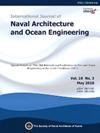Performance analysis of Flettner rotor considering Marine wind profile and ship installation using CFD
IF 3.9
3区 工程技术
Q2 ENGINEERING, MARINE
International Journal of Naval Architecture and Ocean Engineering
Pub Date : 2025-01-01
DOI:10.1016/j.ijnaoe.2025.100653
引用次数: 0
Abstract
The study investigated a Flettner rotor performance on a hull, analyzing design modifications and wind profiles for a small catamaran which designed by KRISO for the K-Energy Observer platform was analyzed. The rotor mounted on the hull showed a nearly 48% performance degradation in lift coefficient compared to the standalone rotor due to the disturbed flow by the hull at spin ratios 3–4. Two design factors were examined to improve performance: foundation shape and bottom configuration of the rotor. A square foundation shape showed relatively better improvement but it was not significant. On the other hand, it was found that the rotating end plate significantly improved thrust, achieving up to 80% of the standalone rotor’s performance. Comparing uniform and Norwegian Petroleum Directorate (NPD) wind profiles, the NPD profile showed a 12% improvement due to stronger winds at the rotor’s upper section. The study also compared performance under different wind directions and it showed a 20% increase at 30° and 18% at 60° for the original configuration. In contrast, the rotating end plate configuration showed a 6% decrease at 30° but a 10% increase at 60°. However, overall performance improvement was observed in the rotating end plate configuration with increases of 12%, 34%, and 44% for 30°, 60° and 90° compared to the original configuration. Additionally, under a 5° inclined hull condition, performance decreased by 21% for the original configuration but only 13% for the rotating end plate configuration, which highlighted the design’s effectiveness in mitigating performance loss.
考虑海上风廓线和船舶安装的Flettner转子性能CFD分析
该研究调查了安装在船体上的 Flettner 转子的性能,分析了 KRISO 为 K-Energy Observer 平台设计的小型双体船的设计修改和风廓线。与独立转子相比,安装在船体上的转子升力系数降低了近 48%,原因是在旋转比为 3-4 时,船体会扰动气流。为提高性能,研究了两个设计因素:基础形状和转子底部配置。方形地基形状的改善效果相对较好,但并不显著。另一方面,研究发现旋转端板显著提高了推力,可达到独立转子性能的 80%。在比较了均匀风和挪威石油局(NPD)风廓线后发现,由于转子上部的风力较强,NPD 风廓线的性能提高了 12%。研究还比较了不同风向下的性能,结果表明,原始配置在 30° 风向下的性能提高了 20%,在 60° 风向下提高了 18%。相比之下,旋转端板配置在 30° 时性能降低了 6%,但在 60° 时提高了 10%。不过,与原始配置相比,旋转端板配置在 30°、60° 和 90°时的总体性能分别提高了 12%、34% 和 44%。此外,在倾斜 5° 的船体条件下,原始配置的性能降低了 21%,而旋转端板配置的性能仅降低了 13%,这凸显了该设计在减少性能损失方面的有效性。
本文章由计算机程序翻译,如有差异,请以英文原文为准。
求助全文
约1分钟内获得全文
求助全文
来源期刊

International Journal of Naval Architecture and Ocean Engineering
ENGINEERING, MARINE-
CiteScore
4.90
自引率
4.50%
发文量
62
审稿时长
12 months
期刊介绍:
International Journal of Naval Architecture and Ocean Engineering provides a forum for engineers and scientists from a wide range of disciplines to present and discuss various phenomena in the utilization and preservation of ocean environment. Without being limited by the traditional categorization, it is encouraged to present advanced technology development and scientific research, as long as they are aimed for more and better human engagement with ocean environment. Topics include, but not limited to: marine hydrodynamics; structural mechanics; marine propulsion system; design methodology & practice; production technology; system dynamics & control; marine equipment technology; materials science; underwater acoustics; ocean remote sensing; and information technology related to ship and marine systems; ocean energy systems; marine environmental engineering; maritime safety engineering; polar & arctic engineering; coastal & port engineering; subsea engineering; and specialized watercraft engineering.
 求助内容:
求助内容: 应助结果提醒方式:
应助结果提醒方式:


